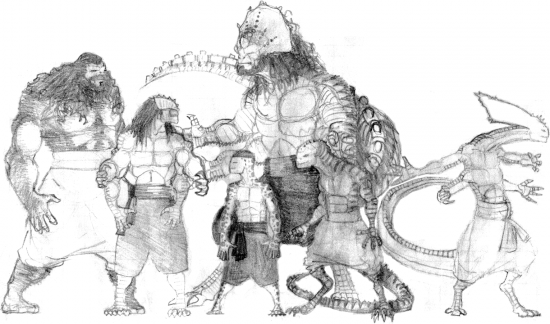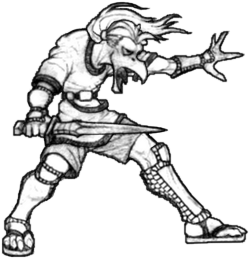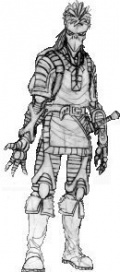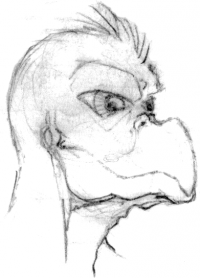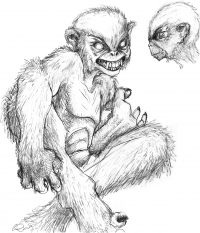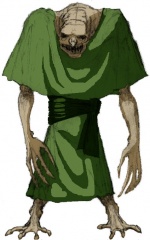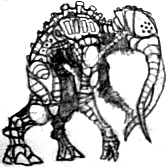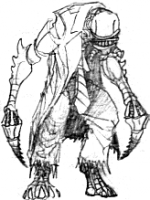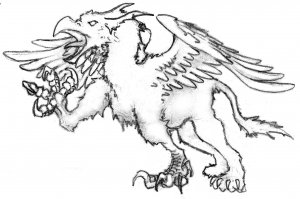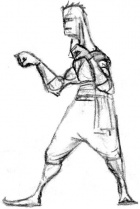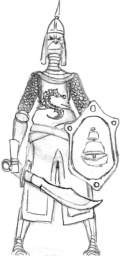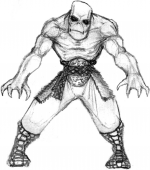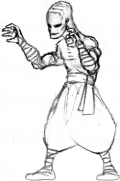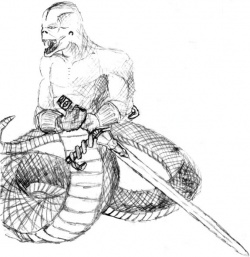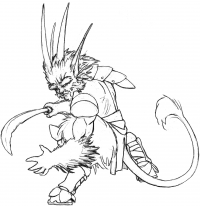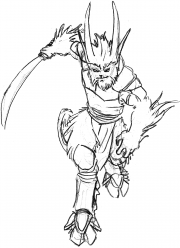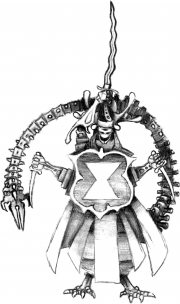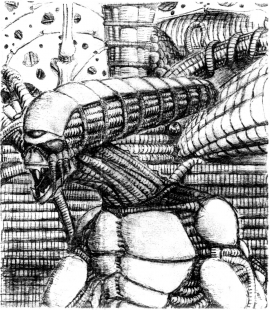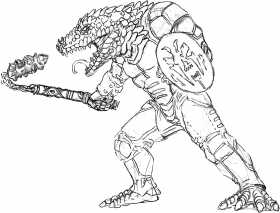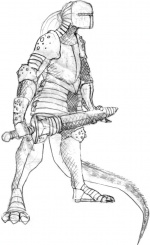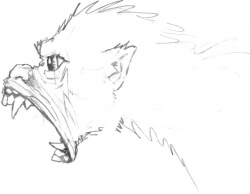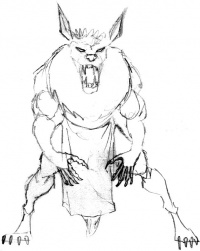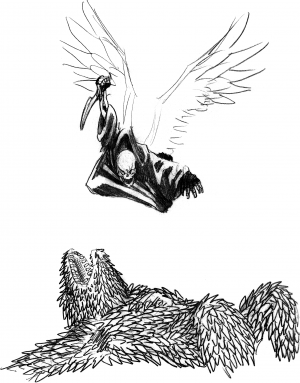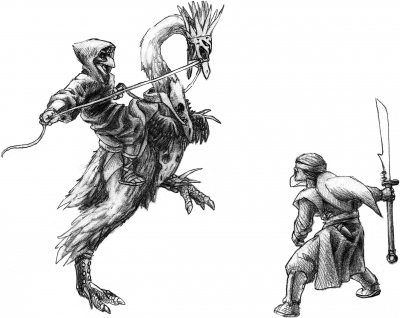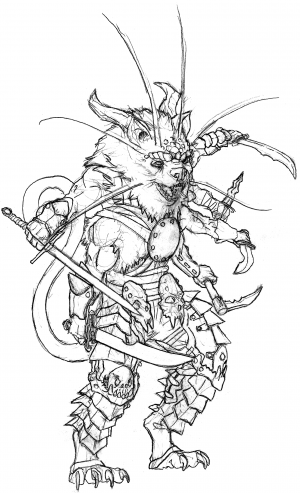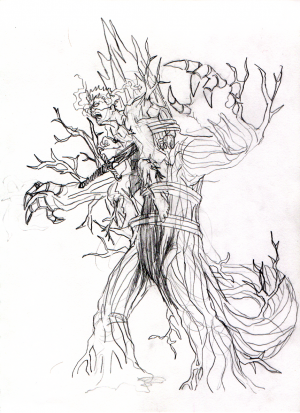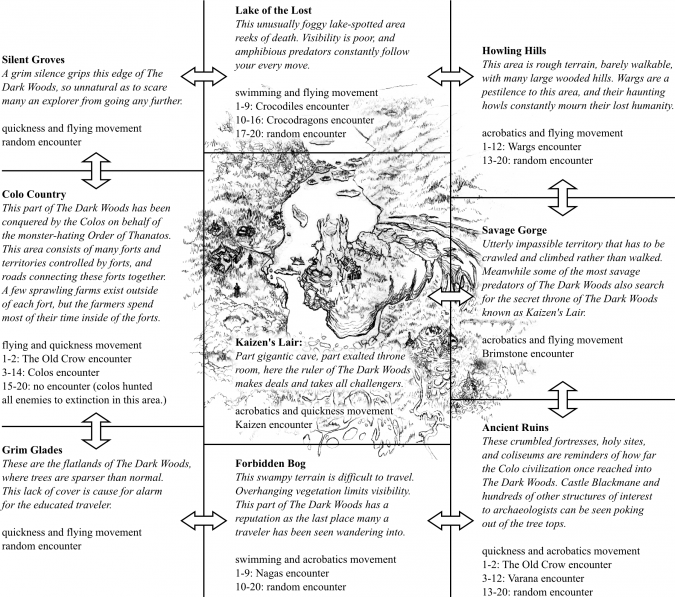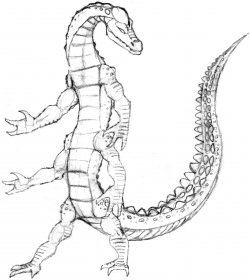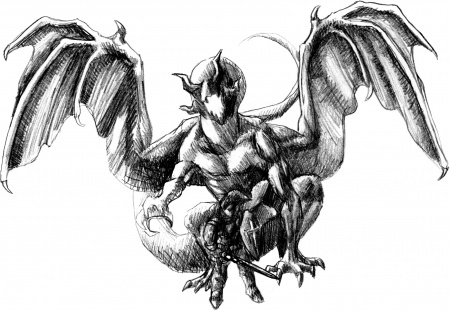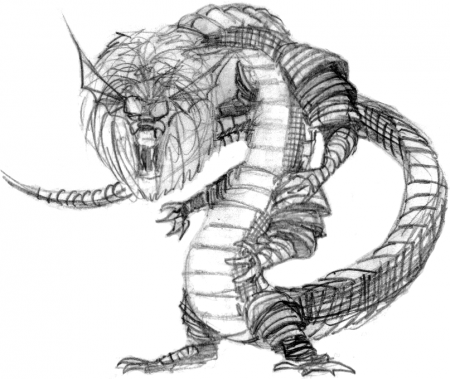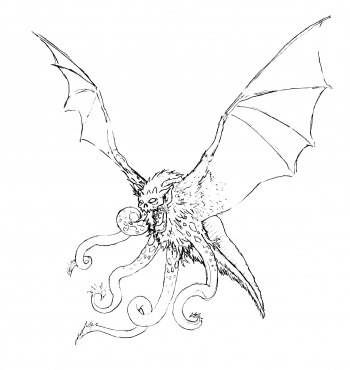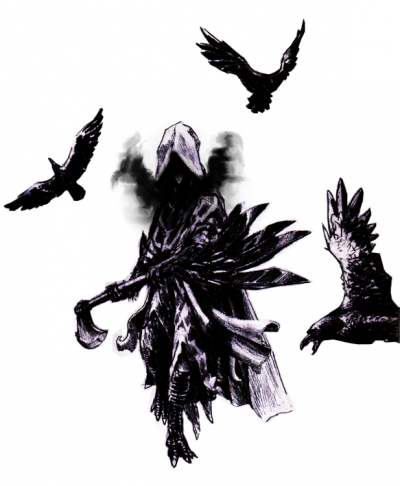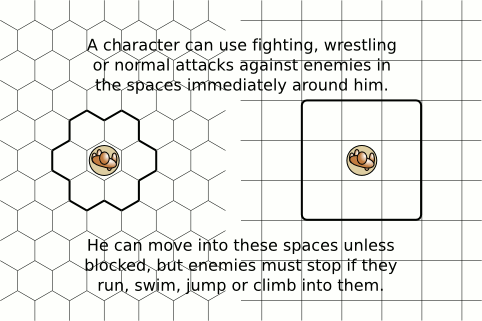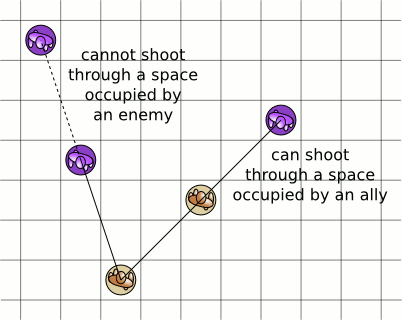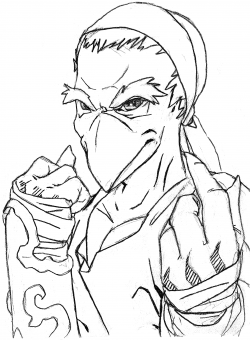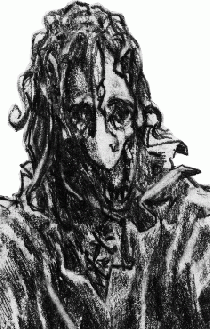A&D Handbook
Contents
Introduction[edit]
The Dark Woods is a Role-Playing Game where players take on the role of monsters and battle each other. The Dark Woods does not have a "game master." The players are divided into two teams of sorcerers - intelligent monsters who become more powerful by defeating enemies. The teams take turns moving on the map and playing the enemies that the other team encounters.
The Dark Woods is licensed under the Creative Commons Attribution Share-alike license (which can be found at http://creativecommons.org/licenses/by-sa/2.5/ .) This means that you can copy, modify and share this game according to the rules of that license. This license applies to all of the art, rules, text, and other content of this game.
We started developing the The Dark Woods in 1994. (Working on The Dark Woods inspired other Game Arts Guild projects, like the Squawk Role-Playing Game .)
Setting[edit]
The Dark Woods is a foreboding place full of monsters and violence. The Dark Woods is a nexus that connects many worlds together. It appears to be an endless forest in a permanent state of twilight, and has many mysterious ruins.
The Dark Woods is rife with mystical power called essence. Creatures higher up on the food chain accumulate more essence. Intelligent creatures who use essence to become more powerful are called sorcerers, or more specifically cannibal sorcerers. Essence changes sorcerers, sometimes warping them into monstrous froms.
The Dark Woods is usually ruled by a powerful sorcerer. Most sorcerers either support the ruler of The Dark Woods, or are involved in plots to overthrow that ruler. The Dark Woods is currently ruled by the six-legged dragon sorcerer Kaizen.
Colos are beaked humanoids from a world like Earth's Triassic period. There they thrived as their homeworld's foremost predator, having a strong pack hunting instinct. They reproduce faster than humans, but have a shorter life span. Colo cultures tend to be focused on heroic accomplishments, like collecting impressive hunting trophies.
Colos indoctrinated and trained by the monster hating Order of Thanatos were introduced to The Dark Woods to end the practice of sorcery. Colo society in The Dark Woods is focused on a crusade to hunt and destroy every sorcerer they can find. These colos live in forts occupied by many large families. The social structure is miltaristic, with each fort led by a "captain" and his many officers.
- "The Order of Thanatos has long recognized The Dark Woods to be a center of great evil amonst the many worlds that this place creeps into. The Order of Thanatos brought us colos here generations ago, because of our explosive population growth and pack hunting instincts. The part of The Dark Woods conquered by the decedents of those colos is now called Colo Country by those of us who dwell here. Know two things for certain. First venturing beyond the borders of Colo Country is a journey into the land of nightmares, and should only be done with careful military planning. Second, if you meet sorcerers, destroying those blights-on-reality is your duty, cause, and reason for existence; we are the angels sent to destroy these demons in their own hell!" - Ruben the Crusader Monk (from an academy lecture a few weeks before his disappearance.)
Boggarts are malevolent faerie folk with a taste for theft and trickery. They appear as small fanged humanoids, covered in fur.
Dragons of the The Dark Woods come in many shapes and sizes. Some are sorcerers who have twisted their bodies into powerful draconic forms.
Dryads are walking, talking plant-humanoid hybrids covered in protective bark. They are fast healers. Dryads are guardians of The Dark Woods, and they have no taboos against sorcery. Dryad sorcerers have been known to take the form of hulking trolls or tentacled trees.
Ghouls are undead who develop grotesque mutations. They can absorb the abilities and features of creatures they eat, including creatures that have no magical essence. Ghouls are from the outbreak that destroyed the home world of the Order of Thanatos, and the order believes the ghouls are related to the essence of The Dark Woods. Creatures killed by ghouls often rise as ghouls themselves if their corpses are intact.
Gryphons have the wings, head and talons of an gigantic eagle and the body and legs of a lion. Gryphons of The Dark Woods are often colo sorcerers who have acquired attributes of big cats and predatory birds on their way to becoming dragons. These gryphons may have unusual features like tiger stripes, leathery bat wings or feathered tails.
Striders are bipedal canine lagomorphs. They have a low center of gravity, long floppy ears and short snouts with ape-like lips. Because striders crave competition and glory, and have a strong natural instinct for loyalty, they are often employed as mercenaries by sorcerers.
Morlocks are subterranean humanoids with large dark eyes and pale, yellowish or gray skin. They are mostly or entirely bald with tiny ears and flat noses. Morlocks evolved from humans before discovering the Dark Woods while exploring time and space.
Morlocks are excellent climbers. Sorcerers that were once morlocks often have telekinetic powers that allow them to levitate things, climb on ceilings or leap unnaturally high.
Morlock settlements are always found underground, and often organized into industrial communes. Settlements ruled by sorcerers are referred to as "morlock cults."
Nagas are serpentine creatures with a humanoid upper body and the lower body of a very large snake. Nagas are legless relatives of varana (see below) and specialize in paralyzing their opponents with venom.
Satyrs are humanoids fram a parallel Earth where primates have horns, hooves and the combined agility of goats and monkeys.
Seekers are giant insects that walk on two legs. They have wickedly sharp, flexible tails, elongated heads, three eyes and four arms. Seekers come from a swampy world with huge bugs and an oxygen-rich atmosphere. Seeker technology avoids fire - which is difficult to control in their native atmosphere - and specializes in medicine, biochemistry, and preserving knowledge. Seekers do not have permanent settlements in The Dark Woods, but they study The Dark Woods and use it to access numerous other worlds.
Seekers hatch from clutches of hundreds of eggs and do not have names until they accomplish something to distinguish themselves as individuals. Seeker are constantly exploring to bring new knowledge home to their hive, recording observations and collecting specimens.
Sorcerers who develop unique anatomy are of particular interest to seeker abductors. Seekers may capture sorcerers to observe their behavior for a short time, they may attack sorcerers without warning to murder and preserve them as anatomical specimens, or they might join causes with a group of sorcerers simply for the opportunity to study a group from the inside.
Varana descended from human treasure hunters who settled permanently in The Dark Woods. Over generations the essence of The Dark Woods has transformed them into a race of lizard men. Varana scavenge The Dark Woods seeking treasure to horde, and get violently territorial about ruins they think hold particularly valuable secrets. They have been known to use their venomous bite as a weapon of last resort.
Wargs are wolf-like humanoids adapted to the hostile environment of The Dark Woods. They are hard to kill and have keen natural senses, sharp fangs and claws, and increased strength.
Wraiths are otherwordly supernatural creatures whose appearance ranges from apparently normal mortals to ghoulish skeletal monstrosities. Each wraith has a recollection of having had a mortal life in it's past. Normally wraiths are ghost-like, unable to manipulate the physical world, but the essence of The Dark Woods causes them to condense, solidify, and become physically powerful.
Wraiths are supposedly created by the angel of death. Pious wraiths worship the angel of death, following religious texts and traditions attributed to this being. The tenets of this religion suggest that wraiths should be the only immortals, and other creatures with unnatural longevity should fall before them. Pious wraiths prefer weapons with symbolic relevance to this philosophy, especially sacrificial knives, sickles, and scythes.
Form Teams[edit]
Divide the players into two teams. Each team will play a gang of sorcerers. These two groups of player characters (PCs) are in a race to see who can defeat Kaizen first, and become the new rulers of The Dark Woods. Each team belongs to an association within The Dark Woods society. Each team of players must choose one (and only one) association for all of their PCs, and the two teams must have different associations.
Colonists[edit]
Your PCs can pass as not-warped-beyond-usual by the essence of The Dark Woods, and the Order of Thanatos does not suspect you of sorcery. The colos are impressed by your apparent piety and mastery of scripture and dogma, and authorize you to explore and colonize The Dark Woods.
Whenever your PCs encounter Colo Crusaders, you can choose to not fight them (and also then not get to feed on their essence.) You can also fight them as normal.
Necromancers[edit]
At least one of your PCs is completely obsessed with mastering the darkest arts, willing to take on any rival power to demonstrate his/her/it's supremacy. The other PCs either share his interests or accommodate him out of fear of what he might do if angered.
Whenever your PCs encounter ghouls or wraiths, you can choose to fight them as normal, or instead have the ghouls or wraiths immediately attack the other team.
Raiders[edit]
Your PCs are a well organized group of experienced plunderers. You are here to take The Dark Woods for all it's worth.
Whenever you successfully defeat boggarts or morlocks, you each get one additional ability point because you are able to shake them down for their local stash of magic items and treasure, before you feed on their essence.
Rangers[edit]
Your PCs have studied philosophy and martial arts with the dryads. You have entered a pact with them to rule The Dark Woods with the utmost care for environmentalism and biodiversity.
Whenever your PCs encounter Dryad Druids, instead of fighting them your encounter is automatically successful, as your PCs take this opportunity to practice zen "rooting" meditation, knock-down "branch-sparring," "tangle vine" Tai Chi and other ancient training techniques that help your PCs focus their essence more efficiently.
Scholars[edit]
At least one of your PCs has a background in helping Seekers collect specimens.
Whenever your party encounters Seeker Abductors, your party can choose to be transported to any space other than Kaizen's Lair, where you will begin your next turn. However, you may not fight the Seeker Abductors or feed on their essence.
Make PCs[edit]
Every player has one personally designed character called a "PC" (or "player character.") This PC feeds on the essence of his fallen foes to become more powerful, technically making it a sorcerer. The antagonist in "The Fall of the Blackmanes" (who is known as The Old Crow in this game,) is one example of a very experienced sorcerer in The Dark Woods. However, these kind of sorcerers can take almost any form. A sorcerer could be a mighty warrior, a dragon, some other dangerous monster, or even something more subtle.
Players should use their imagination, and use the Scratch Role-Playing System (see Basic Rules) to make a sorcerer with a maximum beginning ability level of 8 and a maximum beginning total ability level of 16.
Name:_______________________________ Description:_______________________
_________________________________________________________________________
_________________________________________________________________________
Abilities
Level Ability Description
_____ toughness __________________________________________________
_____ ______________ __________________________________________________
_____ ______________ __________________________________________________
_____ ______________ __________________________________________________
_____ ______________ __________________________________________________
_____ ______________ __________________________________________________
_____ ______________ __________________________________________________
_____ ______________ __________________________________________________
Stamina:_____ Hitpoints:________________________________________________
Defenses
Agility:_________ Intelligence:__________ Strength:___________
An electronic character generator for The Dark Woods can be found at http://gameartsguild.com/dwpc/
Here are some questions to answer when making a good character description of a sorcerer: How does your PC feed on the essence of a fallen foe? (Does your PC use fangs to "suck their blood," make a soup out of them in a large black cauldron, use a talisman to absorb their aura, or some other sinister technique?) What is it about your PC that makes it have the abilities it does? What is the origin of your PC? What shape does your PC have now? How does your PC defend itself? What is your PC's personality like? What equipment does your PC use on a regular basis?
Rules Summary[edit]
The Dark Woods uses the Scratch Role-Playing System for its combat and character creation rules. See the Scratch Role-Playing System chapter for the complete rules.
Stats
- Attack abilities: blasting, shooting, knockout, fighting, wrestling.
- Movement abilities: acrobatics, quickness, flying, swimming.
- Other abilities: toughness, stealth, detection, command, craftsmanship, healing.
- HP: toughness ability level is your maximum hit points.
- Stamina: half of your toughness, rounded down.
- Agility: 10 + stealth, acrobatics, quickness or flying.
- Intelligence: 10 + detection, command, healing or craftsmanship.
- Strength: 7 + toughness, 10 + wrestling or 10 + swimming.
- Initiative: 1d20 + 2 × best stealth + 10 × best detection. (Highest goes first.)
Effects
- Healthy: your HP is greater than your stamina.
- Injured: your HP is less than or equal to your stamina.
- Incapacitated: your HP is 0. (HP cannot be less than 0.)
- Panicked: you must evade or escape. (You cannot attack or heal.)
- Delayed: you cannot move or perform actions.
- Automatic success: roll 20 before adding modifiers, +1 damage.
Basic Actions
- Basic attack: close range, fighting, wrestling or knockout vs. agility, 1 damage.
- Throw object: long range, roll vs. agility, 1 damage.
- Hold: close range, wrestling, detection, or movement ability vs. strength, target delayed until end of his next turn, loses evade bonus.
- Distract: unrepeatable, close range, movement ability vs. intelligence, target delayed until end of his next turn.
- Evade: add movement ability to agility and strength until your next turn.
- Escape: leave combat if you evaded on your last turn.
- Engage: bonus action before close range attack, +2 to that attack, -2 agility until the beginning of your next turn.
- Take cover: bonus action before long range attack, -2 to that attack, +2 agility until the beginning of your next turn.
Using Abilities
- Shooting: long range, shooting vs. agility, 2 damage (5 if automatically successful), delay yourself if you are injured.
- Blasting: long range, 3 separate targets, blasting vs. agility, 1 damage, delay yourself if you are injured.
- Knockout: close range, knockout vs. agility, 2 damage (4 if healthy), delay yourself.
- Fighting: two basic attacks using fighting ability as a single action if you are healthy.
- Wrestling: hold using wrestling does 1 damage if you are healthy and not delayed. If you are healthy and delayed, hold anyone who has held you since your last turn.
- Surprise: unrepeatable, long range, stealth or detection vs. intelligence, target panicked until the end of his next turn.
- Swimming: bonus to agility and close range attack rolls in water.
- Healing: healing vs. 10, increase injured ally's HP to stamina + 1, or give incapacitated ally 1 HP.
- Craftsmanship: +1 bonuses to abilities you and your allies already have.
- Command: 1 or 2 minions whose total CP is your command level. Minions cannot be healed.
- Intimidate: unrepeatable, long range, command vs. intelligence or strength, whichever is greater, target panicked until the end of his next turn.
Example PCs[edit]
Smolder (13 agility, 12 intelligence, 15 strength, 4 stamina) is a colo sorcerer turned winged fire breathing dragon, looking to take the throne for himself. He absorbs essence by swallowing his opponents whole when possible, and in pieces when not.
2 blasting: fire-breathing
1 knock-out: huge, natural weapons
3 flying: winged
2 detection: high-flying perspective
8 toughness: bigger than a horse and growing fast
Henry (13 agility, 10 intelligence, 10 strength, 1 stamina) is a human hunter from another world, looking for challenging game. He is armed with a powerful hunting rifle. Eager to try exotic foods, he absorbs essence by roasting meat over open flames, with a new wolf-like disregard for the etiquette he had once mastered on his homeworld.
3 stealth: experienced hunter, new wolf-like instincts
6 shooting: long range rifle with scope,
4 knockout: from-hip shots at specific organs, new wolf-like reflexes
3 toughness: normal human size
Katzenjammer (12 agility, 12 intelligence, 14 strength, 3 stamina) is the six-limbed dragon son of Kaizen, who is plotting to take Kaizen's throne. Inhales the smoke of his burning foes to absorb their essence.
2 stealth: trickster
2 detection: wisdom of the ancients
3 wrestling: deceptive self defense
3 shooting: fire ball
6 toughness: as big as a horse
Necro (11 agility, 16 intelligence, 10 strength, 1 stamina) is a morlock sorcerer turned evil mage, bent on mastering the power of The Dark Woods. He absorbs the essence of his fallen enemies by looking into their eyes as they die.
1 acrobatics: former 3 dimensional lifestyle
6 blasting: chain lighting attack
6 command: 2 zombies
3 toughness: human sized
Necro's Zombie (10 agility, 10 intelligence, 9 strength, 0 stamina)
2 toughness: unmotivated, slow, and easy to topple
1 wrestling: dog-pile overwhelm
Talonis (14 agility, 10 intelligence, 13 strength, 3 stamina) is a colo sorcerer turned gryphon, looking to be involved in whatever new dynasty takes over The Dark Woods next. He tears out and devours the hearts of his fallen foes in order to absorb their essence.
4 flying: winged
6 fighting: talons, beak, claws, experienced brawler
6 toughness: as big as a horse
Wanderlust (12 agility, 12 intelligence, 14 strength, 3 stamina) is a dryad sorcerer looking to take control of The Dark Woods for the dryads. He buries remains of his foes and ponders the meaning of their life in order to absorb their essence.
2 healing: tentacle injects a blood/sap parasite stimulant
2 stealth: one with nature
3 wrestling: dryad Tai Chi
2 knockout: mallet fist
7 toughness: larger than human, protective bark
Map[edit]
If one team has more players than the other, the smaller team should go first. If both teams have the same number of players, then a player should roll a 20 sided die. If this roll is greater than 10, then his team goes first. Otherwise, the other team goes first.
At the beginning of the first team's turn, one player on that team should roll a 20 sided die. If this roll is greater than 10, then his team's first encounter is on the Silent Groves space and the other team's first encounter is at the Grim Glades. If the player rolls 10 or less, then his team's first encounter is at the Grim Glades and the other team's first encounter is at the Silent Groves.
Before a team has an encounter on their turn, they can move one space. If neither team has visited the new space, one of the players should read the description of that space (the text in italics.) The new space will tell the players which encounter they have at this space, or it will have a table for choosing encounters with a die roll. Do not repeat the encounter or roll for another encounter on that space unless the team moves off that space and then back onto it. Teams can only enter Kaizen's Lair in the middle of the map from the Savage Gorge space.
Each space indicates which movement abilities can be used to evade and catch evading enemies in that space. (This only affects the evade and catch actions. It does not affect normal agility.) If one of the movement abilities listed is swimming, then swimming ability bonuses from being in water also apply in that space.
Encounters[edit]
When a team takes on enemies, there is always an equal number of enemies to team members. The opposing team's players controls the enemies to see what kind of damage they can do to this team.
If a team defeats all of their enemies in an encounter, then that encounter is successful, and each character on that team gets one ability level to add to any ability they choose. This is because they are able to feed on the essence from their fallen foes, dramatically enhancing their power.
If the team is not successful, but at least one of the team members successfully flee, then their encounter is not successful, but they continue the game as normal on their next turn.
If the team is not successful, and none of the team members escape, then the team moves back to the space they started on their first turn, which is where they begin on their next turn.
Random Encounters[edit]
If "random encounter" is called for, roll a 20 sided dice to see which of the following encounters happens (never do the same encounter twice in a row for each team - if the team did the roll encounter the as their last combat-encounter, then roll again):
1: Boggarts
2-4: Colos
5-7: Dryads
8-9: Ghouls
10: Hunters
11-12: Morlocks
13: The Old Crow
14: Satyrs
15: Striders
16-18: Seekers
19: Wargs
20: Wraiths
Team vs. Team[edit]
If the two teams ever go on the same space, and either team wishes to fight, then the teams will directly engage each other in combat. All of normal rules apply to this combat as with other encounters, except that the winning team does not gain an ability level from the encounter (because they are not able to drain the essence of the other PCs.)
If one team is smaller than the other, than the larger team must choose which of it's PCs will fight the smaller team, and they should choose the same number of PCs that the smaller team has.
Extending the Game[edit]
If the game ends too quickly and the players wish to play on after one team has defeated Kaizen, replace Kaizen and his minions with the team that dispatched him. Have the players of those characters make up a new characters. Divide the team that did not win into two new teams, and have the new characters join one of the new teams.
List of Encounters[edit]
Boggarts[edit]
Hairy boggarts drop on you from the trees. They scratch and bite you while tugging at your possessions.
Boggart Robbers (15 agility, 10 intelligence, 14 strength, 1 stamina)
5 stealth: silent, almost invisible
5 wrestling: clever fighting style that ties up opponents
3 toughness: small stature
Colos[edit]
A patrol of heavily armored colos recognize you as sorcerers and attack with righteous fury.
Colo Crusaders (12 agility, 10 intelligence, 12 strength, 2 stamina)
2 stealth: hunting experience
5 fighting: close range weapons, martial arts
2 shooting: hunting weapons
5 toughness: well armored and conditioned soldiers
Crocodragon[edit]
Hungry crocodragons, longer than a crocodile, with serpentine bodies and six powerful clawed arms, are stalking you.
Hungry Crocodragon (13 agility, 10 intelligence, 13 strength, 2 stamina)
2 swimming: amphibious lifestyle
4 wrestling: python fighting style
3 stealth: clever hunters
4 toughness: larger than humans
Brimstone[edit]
The giant fire-breathing dragon Brimstone guards the wilderness near Kaizen's lair. According to legend, she was once a colo sorceress apprenticed to Kaizen. Over time, Brimstone used the essence of The Dark Woods to transform herself and her disciples into huge dragons and gryphons.
If each member of your party makes a flying, acrobatics or swimming roll of 12, you can sneak past Brimstone's patrols and instead have a random encounter. If any of you fail your roll, Brimstone's guardian gryphons spot you and you must fight her.
After you defeat Brimstone and feed on her essence, Kaizen uses his dark magic to resurrect Brimstone and restore her power. So any time a party enters this area they must roll to avoid Brimstone no matter how many times she has been defeated.
Brimstone (13 agility, 13 intelligence, 19 strength, 6 stamina)
3 detection: eagle eyed
4 blasting: fire breathing
3 knockout: giant talons
3 flying: winged
12 toughness: larger than elephant, extensive natural armor
Guardian Gryphon (13 agility, 13 intelligence, 13 strength, 3 stamina)
3 detection: eagle eyed
3 flying: winged
8 fighting: talons, beak, claws, natural brawler, experienced fighter
6 toughness: as big as a horse
Dryads[edit]
Dryad druids overhear your plans for taking over the Dark Woods when you depose Kaizen. They decide their own plans serve the forest's health better, and prepare an ambush.
Dryad Druids (13 agility, 10 intelligence, 13 strength, 3 stamina)
3 stealth: one with nature
3 wrestling: dryad Tai Chi
2 knockout: mallet fist
6 toughness: larger than human, protective bark
Ghouls[edit]
Hungry Ghouls from a fallen world have wandered here search of flesh, and attack you in ravenous desperation.
Hungry Ghouls (10 agility, 10 intelligence, 14 strength, 2 stamina)
3 knockout: contagious bite
5 wrestling: mutant appendages
5 toughness: hard to kill
Hunters[edit]
Human hunters have entered The Dark Woods stalking supernatural prey, and have targeted you.
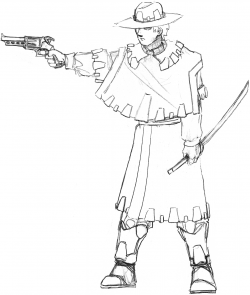
|
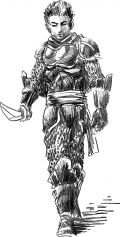
|
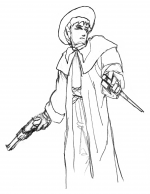
|
Hunter (13 agility, 11 intelligence, 11 strength, 2 stamina)
1 detection: sense evil
3 stealth: ambush, wolf-like reflexes
3 shooting: silver bullets
2 fighting: oak stakes, martial arts, swords
4 toughness: leather armor
Kaizen[edit]
You have heard that Kaizen was born a strider, but many years of practicing sorcery have transformed him into a six-legged dragon.
When your team first encounters Kaizen, he makes you an offer. For joining his side and making a pact to never return unless he summons you, Kaizen will bestow magical power on your team. If you accept the offer, each PC on your team receives 1 CP, and your team goes to their original starting position on their next turn.
If you refuse to join him, or if you return to Kaizen's Lair after agreeing to his bargain, Kaizen and his summons flying monstrosities and attacks your team.
Kaizen (16 agility, 16 intelligence, 19 strength, 6 stamina) is large, armored, fast, extremely clever, and has a fiery breath weapon. He feeds on essence by inhaling the smoke from his victims burning corpses.
6 detection: master trickster
6 acrobatics: gravity-defying dexterity
6 blasting: exploding fire-ball breath-weapon
6 knockout: giant tail slap
12 toughness: elephant sized, impenatrable dragon hide
Hell Bat (17 agility, 12 intelligence, 17 strength, 2 stamina)
2 detection: bat-radar
7 flying: like a bat out of hell
8 wrestling: unstoppable tentacles
4 toughness: larger than most humans
Morlocks[edit]
Concerned that you might be speculating on the value of their property, Morlock Underminers attack using acrobatic rope techniques and pick-axes.
Morlock Underminers (13 agility, 10 intelligence, 12 strength, 2 stamina)
3 acrobatics: climbing on ceilings and through vertical mine shafts
4 blasting: mining explosive experts
2 wrestling: skilled with climbing ropes
4 toughness: human sized, hardened lifestyle
Nagas[edit]
You are ambushed by half-human, half-snake creatures interested in any artifacts your party may have found in their travels.
Naga Bandits (12 agility, 10 intelligence, 12 strength, 1 stamina)
2 swimming: serpentine tails
2 knockout: venomous bite
2 stealth: reptilian patience
4 fighting: poisoned hand weapons
3 toughness: human sized
The Old Crow[edit]
The Old Crow was one of the original Blackmanes, a tribe of zealots converted to the Order of Thanatos on the colo home world. Studying and hunting sorcerers eventually transformed The Old Crow into a monster herself. Centuries later, she is one of the most feared sorcerers in The Dark Woods.
The Old Crow attacks suddenly as you are assaulted from every direction by mobs of angry crows.
The Old Crow (15 agility, 15 intelligence, 15 strength, 3 stamina)
5 wrestling: expert illusionist, terrifying and intimidating her enemies in close quarters
5 knockout: concealed executioner's axe and deadly underhanded techniques
5 detection: She wears a large dark cloak and robes, and emits a mysterious dark fog around her person, allowing her to observe enemies from a safe, high location before they notice her.
5 acrobatics: She has evolved crow-like features, with large black feathers giving her forearms a wing-like appearance.
7 toughness: is supernaturally fast and strong
Attack Crow Swarms (14 agility, 10 intelligence, 12 strength, 2 stamina)
4 blasting: fall on opponents like rain
4 flying: winged birds
5 toughness: many individual crows
If the Old Crow is defeated, she explodes into black smoke and disappears. The Old Crow absorbs the essence of her fallen prey by draining the victim's blood into rose bushes, then eating the roses. Her rose bushes emerge from the ground as she is preparing to feed, wherever she is. If the PCs can defeat her, they drain essence from her roses.
Satyrs[edit]
Satyr bounty hunters confront you because an old enemy has placed a price on your head.
Satyr Bounty Hunters (14 agility, 10 intelligence, 12 strength, 2 stamina)
4 fighting: horns, hoofs, blades and temper
4 quickness: natural sprinters
5 toughness: good conditioning, lite armor
Seekers[edit]
Well armed seekers attempt to collect you as samples, to study your unique sorcerer anatomy.
Seeker Abductors (12 agility, 12 intelligence, 12 strength, 2 stamina)
4 fighting: nasty natural weapons, kidnapping technique
2 stealth: hunting experience
2 detection: three eyed animal psychology experts
5 toughness: exoskeleton
Striders[edit]
Strider mercenaries, hired by relatives of your past victims, have finally tracked you down to avenge their clients.
Strider Mercenaries (13 agility, 10 intelligence, 12 strength, 2 stamina)
3 quickness: natural runners, well conditioned
4 fighting: midevil weapons, mercenary combat experience
1 shooting: light weight crossbows
5 toughness: well conditioned and well armored
Varana[edit]
You are ambushed by varana who suspect you of trying to find ruins they are protecting.
Varana Guardians (13 agility, 10 intelligence, 12 strength, 2 stamina)
3 knockout: poison bite
3 stealth: reptillian patience
2 fighting: hand to hand weapons
5 toughness: human sized, armored
Wargs[edit]
Warg Hunters are out looking for food, and you are the most appetizing prey they have seen all day.
Warg Hunters (12 agility, 12 intelligence, 12 strength, 2 stamina)
2 detection: wolf-like senses
2 quickness: sprinting
4 fighting: nasty teath and claws, group attacks
5 toughness: hard to kill
Wraiths[edit]
You are set upon by Harvesters, gruesome skeletal and religously devout wraiths, with no tolerance for your sorcery.
Harvesters (12 agility, 12 intelligence, 12 strength, 2 stamina)
2 healing: hold the power of life and death
2 flying: winged
4 fighting: razor-sharp ceremonial knives, swooping attacks
5 toughness: bony skeletal exterior and thick ceremonial cloaks
Scratch Role-Playing System[edit]
The Scratch RPS provides simple rules for role-playing games (RPGs.) In an RPG, each player takes on the role of a character in a story or simulation. People play RPGs to have fun and socialize, but they can also be a fun way to practice basic math and problem-solving skills. A Scratch RPS character looks something like this:
Zimzambamalam (10 agility, 10 intelligence, 10 strength, 1 stamina): a master of magic
8 shooting: destroys enemies with bolts of lightning from his fingertips
2 toughness: relies on the awesome power of his magic alone
Each character has some abilities, and each of those abilities has a level. If a character does not have at least one level of an ability, the character does not have that ability and cannot use that ability.
Rolls[edit]
Some actions, like a character attacking another character, have a chance of success and a chance of failure. To determine whether the action succeeds, roll a twenty-sided die. (If you do not have a twenty-sided die, see "Twenty-Sided Die Alternatives" below.) Modifiers, such as ability levels, are then added to certain types of rolls. If the total is greater than or equal to the difficulty of the action, then the action succeeds. If the die roll is 20 before adding an ability level or other modifiers, then the action is automatically successful. If the die roll is not 20 and the total is less than the difficulty, the action fails.
Rolls may allow a character to use specific ability levels as a modifier. "Make a command roll (difficulty 25)" or "beat a command roll of 25" means a player can roll a twenty-sided die. If he has at least one level of command ability, then he can add his command ability level to the roll. The character is only successful if the total is equal to or greater than 25, or the player rolls a 20 before adding his character's command ability. As another example, suppose a character with 3 levels of craftsmanship ability has to make a craftsmanship roll of 15. He rolls 12, and 12 plus 3 is equal to the difficulty 15, so he is barely successful.
Some rolls require specific abilities. "Make a healing roll (difficulty 11, requires healing ability)" or "Make a healing roll of 11 (requires healing)" means a character can only attempt the action if they have at least one level of healing ability. If they do have at least one level of healing ability, they can add their healing ability to a twenty-sided die roll, and the action is successful if the roll is 11 or greater.
Turns[edit]
Each person controlling characters has an initiative group. This group contains the characters that person controls. Initiative groups take turns during encounters. At the beginning of each encounter, roll a twenty-sided die for each initiative group to determine the order of their turns. This is the group's initiative roll. Groups take turns in order from the highest initiative to the lowest. If two groups have the same initiative, break the tie by rolling another die for both groups until one of them rolls higher. That group goes before the other. Each character has a turn during each turn of their initiative group. The player controlling the group chooses the order of the turns of the characters in the group.
Regular actions require a character's full attention, so characters can only perform one regular action per turn. Most actions are regular actions.
Bonus actions do not require a character's full attention, so characters can perform one bonus action in addition to their regular action each turn. Bonus actions include opening a door, pushing a button or handing an item to another character.
Unrepeatable actions can only be used once per encounter. For example suppose that a sherriff and an outlaw are stalking each other. Both characters can use the unrepeatable surprise action. Both characters can surprise each other, but the sheriff can only surprise the outlaw one time and the outlaw can only surprise the sheriff one time.
Hit Points[edit]
Characters have hit points which determine whether they are healthy, injured or incapacitated. A character's toughness ability level is his maximum hit points. Stamina is half of a character's toughness, rounded down. A healthy character has more hit points than his stamina. An injured character has at least one hit point but no more hit points than his stamina. Characters can never have less than zero hit points. A character with zero hit points is incapacitated and cannot perform actions.
For example, if a character has 7 toughness, his stamina would be 3, so he would be healthy when his hit points are 4, 5, 6 or 7, injured when his hit points 1, 2 or 3, and incapacitated when his hit points are 0.
Some attacks cause damage when they are successful. Each point of damage reduces the target's hit points by 1. When an attack that causes damage is automatically successful, it causes 1 extra point of damage. An attack that normally causes 3 damage will do 4 damage when it is automatically successful. An attack that delays an opponent without causing damage still does no damage when it is automatically successful.
Defenses[edit]
Agility is 10 plus the character's stealth, acrobatics, quickness or flying ability level, whichever is greater. If the character does not have one of those abilities, his agility is 10. Agility is the difficulty of normal attacks which should be physically avoided or blocked. If a character has 2 levels of acrobatics and 3 levels of quickness, then his agility is 13. If he is targeted by a normal attack and the attacker's roll is 13 or more, then attack is successful. (If the roll is 12 or less the attack fails fails.)
Intelligence is 10 plus the character's detection, command, healing or craftsmanship ability level, whichever is greater. If the character does not have one of those abilities, his intelligence is 10. Intelligence is the difficulty of actions like deception, persuasion, intimidation, mind reading and mind control. These are called psychic attacks regardless of whether their power is psychological or supernatural.
Strength is 10 plus the character's wrestling or swimming ability level, whichever is greater. If the character does not have one of those abilities, his strength is 7 plus his toughness. This is the difficulty of force attacks that should be resisted physically, but not by moving out of the way or parrying the attack.
Strength can be used to estimate how much weight a character can carry or lift.
A character can carry a heavy pack all day if the pack does not weigh more than 2 kg (4.4 lbs) for every point of the character’s strength. A character can carry a heavier weight for a few minutes if it does not weigh more than 5 kg (11 lbs) for every strength point. A character can lift a very heavy object without carrying it around if the object does not weigh more than 10 kg (22 lbs) for every strength point. A character can also drag any weight he can lift a short distance.
These are not firm limits. A character may be able to pack, carry, or lift more weight if he travels a shorter distance, stops to rest frequently, or pushes himself to the limit (which might require an ability or non-ability roll, and could result in injury.)
| strength | pack long distance | carry short distance | lift in one place |
|---|---|---|---|
| 10 | 20 kg (44 lbs) | 50 kg (110 lbs) | 100 kg (220 lbs) |
| 11 | 22 kg (48 lbs) | 55 kg (120 lbs) | 110 kg (240 lbs) |
| 12 | 24 kg (53 lbs) | 60 kg (130 lbs) | 120 kg (260 lbs) |
| 13 | 26 kg (57 lbs) | 65 kg (145 lbs) | 130 kg (290 lbs) |
| 14 | 28 kg (62 lbs) | 70 kg (155 lbs) | 140 kg (310 lbs) |
| 15 | 30 kg (66 lbs) | 75 kg (165 lbs) | 150 kg (330 lbs) |
| 16 | 32 kg (70 lbs) | 80 kg (175 lbs) | 160 kg (350 lbs) |
| 17 | 34 kg (75 lbs) | 85 kg (185 lbs) | 170 kg (370 lbs) |
| 18 | 36 kg (79 lbs) | 90 kg (200 lbs) | 180 kg (400 lbs) |
| 19 | 38 kg (84 lbs) | 95 kg (210 lbs) | 190 kg (420 lbs) |
| 20 | 40 kg (88 lbs) | 100 kg (220 lbs) | 200 kg (440 lbs) |
Basic Actions[edit]
Every character can do these basic actions or do nothing when it is their turn.
Basic attack is a close range normal attack. Make a roll against the target's agility. If the attack is successful, it causes 1 damage. Basic attacks are usually weapon strikes or unarmed strikes.
Throw object is a long range normal attack. Make a roll against the target's agility. If the attack is successful, it causes 1 damage. A character can only use this attack if a dangerous throwable object like a rock or chair is available.
Hold is a close range force attack. Make a roll against the target's strength. If the hold is successful, it delays the target until the end of the target's next turn. A successful hold also stops the target from evading.
Distract is an unrepeatable close range psychic attack. Make a roll against the target's intelligence. If the distraction is successful, the target is delayed until the end of his next turn.
Evade is a regular action which allows the evading character to add a movement ability level to his agility and strength until his next turn or until he is held, whichever comes first. A character without one of those abilities can also evade, but his agility and strength do not change.
Escape is a regular action which allows a character to leave an encounter. A character can escape if he evaded on his last turn. The character cannot perform actions or be attacked for the rest of the encounter.
Engage is a bonus action which an attacker can use before a close range attack. The attacker adds 2 to his close range attack rolls until the end of his current turn, but the attacker's agility is reduced by 2 until the beginning of his next turn. Lowering the attacker's agility may encourage enemies to target the attacker instead of his allies.
Take cover is a bonus action which a character can use before performing any other actions on his turn. A character can only take cover if there is some kind of cover, like a hill, a wall or a large box to hide behind. While the character is in cover, his agility is increased by 2, but he subtracts 2 from all of his rolls. The character can remain in cover as long as he wants and leave cover whenever he wants, but he cannot evade, use close range attacks, distract, surprise or intimidate from cover.
Abilities[edit]
Characters typically have between three and six abilities. All characters have toughness, most have at least one attack ability, and many have a defensive ability.
Characters may be created by distributing character points (CP) between 1 or more abilities. Each CP gives the character one ability level of that ability. No ability can receive more levels than a certain maximum level. The characters in the combat example which follows the list of abilities below were created with 10 CP and a maximum level of 4. These are good limits for making characters that are like average people. Chokestar was created by distributing 2 CP to piloting ability, 2 CP to toughness ability, 3 CP to wrestling ability and 3 CP to stalking ability, for a total of 10 ability levels, and no more than 4 levels of any single ability.
Maximum level limit requires a character to divide his ability levels between a variety of abilities instead of putting all of his levels into a single ability. For example, in a game where characters are slightly more powerful than the average person, they might start with 12 CP and a maximum level limit of 5. Characters in this game would have to divide their CP between at least three abilities.
Appropriate abilities, CP and maximum levels for new characters depend on the setting and type of character being created. Scratch RPS abilities can be loosely interpreted or adapted to a wide variety of settings and types of characters. For example, shooting could be used with guns, bows, other ranged weapons or magic powers. See Scratch:Example Characters for more examples.
Toughness[edit]
Toughness ability level is a character's maximum hit points. Characters without toughness may not perform actions during encounters. An average person without armor has 3 toughness. Less toughness could represent fragility or lack of determination. A child or elderly person might have only 2 toughness. More toughness could represent armor, endurance or size. A big person without armor or conditioning might have 4 toughness. The average horse could have 6 toughness, and the average elephant might have 10 toughness. Training and experience could give a character 1 or 2 more levels of toughness, and heavy armor might give a character 2 more levels of toughness, so a big, heavily armored veteran warrior could have 8 toughness.
Attack Abilities[edit]
Shooting is used to perform a powerful long range normal attack against one character. Shooting could represent guns, bows, throwing spears or powers that damage an enemy from a distance. Make a shooting roll against the target's agility. If the attack is successful, it causes 2 damage. If the attack is automatically successful it causes 5 damage instead of 3 damage. When an injured character uses this attack he delays himself until the end of his next turn.
Blasting is used to attack multiple opponents simultaneously. Blasting could represent explosive or spraying attacks like grenades, a submachine gun or breathing fire. The blasting attack is a long range normal attack which targets up to three separate enemies. A character cannot target a single target more than once with the same blasting attack. Make a blasting roll against the agility of each target. Each target successfully attacked receives 1 damage. When an injured character uses this attack he delays himself until the end of his next turn.
Knockout is used to perform an extremely devastating close range normal attack against a single target. Knockout could represent a powerful bludgeoning weapon, deadly assassination techniques, fast-acting venom or a very large character simply crushing his enemies. If the attacker is healthy, the attack causes 4 damage. If the attacker is injured, it causes 2 damage. When a character does a knockout attack he delays himself until the end of his next turn. Knockout ability level can also be added to basic attack rolls if no other abilities have been added to them.
Fighting ability level can be used to make basic attack rolls. If the attacker is healthy he can do two basic attacks as a single action, using his fighting ability level for both rolls. Fighting could represent prowess with swords, other close range weapons, natural weapons or powerful striking martial arts.
Wrestling ability level can be added to make basic attack and hold rolls. Holds using wrestling ability cause 1 damage when the attacker is healthy and not delayed. Wrestling holds could represent chokes, locks and throws or a mixture of grappling and striking techniques. Normally delayed characters cannot perform actions, but when a character with wrestling ability is healthy and delayed, he can use wrestling to hold a character who has successfully held him since his last turn. This hold while delayed causes no damage.
Stalking Abilities[edit]
Stealth helps a character go first in combat by sneaking around. Stealth could represent camouflage, moving silently, hiding in shadows or slinking close to the ground. Add 2 times the highest stealth ability level of any character in an initiative group to that group's initiative roll. If an initiative group has a character with 3 levels of stealth and another character with 1 level of stealth, add 6 to the group's initiative roll.
Detection helps a character go first in combat by detecting enemies who are sneaking around. Detection could represent alertness, perception, keen senses or tracking skills. Add 10 times the highest detection ability level of any character in an initiative group to that group's initiative roll. If an initiative group has a character with 5 levels of detection and another character with 3 levels of detection, add 50 to the group's initiative roll. A character can use this ability to make hold rolls.
Surprise is an unrepeatable long range psychic attack that requires stealth or detection ability. Make a stealth or detection roll versus the target's intelligence. If the attack is successful, the target is panicked until the end of his next turn. Panicked characters must evade or escape. They cannot attack or heal.
Movement Abilities[edit]
A character can use movement abilities to evade or make distract and hold rolls, but only when the character is in the right type of terrain.
Acrobatics is used to get up, across, or over three-dimensional structures and obstacles like ropes, nets, ledges, ladders, fences, trees and cliffs. Acrobatics could represent good balance, climbing, or jumping or an aptitude for maneuvering around obstacles. It can also represent using equipment which helps a character do those things.
Quickness is used for movement on relatively level ground. Quickness could represent combat footwork, sprinting speed, or being able to keep moving without getting exhausted.
Flying is used to move through the air when there is room to fly. (There is usually room to fly outdoors but not indoors.) A character with no flying ability cannot fly, and cannot get flying ability without a good explanation for why he can fly now when he could not fly before. Flying could represent wings, a jetpack or other means of defying gravity. When a flying character evades or uses a long range attack, he cannot be attacked with a close range attack until his next turn, unless the attacker can also fly.
Swimming is used to move in water. A character without this ability does not know how to swim. One or two levels of swimming could represent trained human ability and natural talent. Higher levels of the ability could represent special equipment for maneuvering in water (like fins) or a streamlined body more suited for swimming. When a character is in water, add his swimming ability to his agility and close range attack rolls in addition to the ability levels normally added to agility and attack rolls. In deep water, characters who use swimming ability to evade cannot be attacked with long range attacks or characters who do not have swimming ability.
Support Abilities[edit]
Healing allows a character to try to revive incapacitated characters and heal injured characters. Healing ability could represent emergency medicine training, fast-acting potions, or miraculous healing powers. A character cannot heal himself with this ability. The difficulty of reviving an incapacitated character is 10. The difficulty of healing an injured character is 10. After being successfully revived a character is still injured, and has only one hit point. After being successfully healed a character is barely healthy, with 1 hit point more than half of his maximum hit points (rounded down.)
Craftsmanship is an ability which allows a character to maintain and improve his allies' equipment. This ability could represent traditional crafts like woodcarving and blacksmithing mastery or high technology like auto mechanics, electrical engineering and robotics. For each level of this ability, a character can give a traveling companion a temporary +1 bonus to an ability which is already at least level 1. He cannot give a second temporary bonus to an ability which has a temporary bonus from himself or someone else. The bonus lasts until he removes it or they are no longer traveling companions. He cannot remove or add bonuses during an encounter. He must make a success roll to add a temporary bonus in a hurry (usually difficulty 10.) If the roll fails he cannot use that temporary bonus until he is no longer in a hurry.
Command is an ability that provides a character with one or two minions. Command could represent charisma to attract followers, rank that provides you with underlings, or teaching ability and students. The total CP of these minions is no greater than the character's command ability level, and they cannot have command ability. A character 4 command could have 1 minion with 4 total ability levels, 2 minions with 2 total ability levels each, or a minion with 1 toughness and another minion with 3 total ability levels. For example:
The Boss (10 agility, 11 intelligence, 11 strength, 1 stamina): an enforcer in a white suit
2 shooting: submachine gun
1 detection: street smart
4 command: accompanied by two thugs.
3 toughness
Thugs (10 agility, 10 intelligence, 10 strength, 1 stamina): concealing blunt weapons under their long overcoats
2 toughness: big, but not powerfully motivated.
Minions can continue fighting even after their leader has escaped or been incapacitated. Minions cannot be healed by using healing ability during an encounter.
Intimidate is an unrepeatable long range psychic attack that requires command ability. Make a command roll versus the target's intelligence or strength, whichever is greater. If the attack is successful, the target is panicked until the end of his next turn. Panicked characters must evade or escape. They cannot attack or heal.
Combat Example[edit]
Breakhelm X-19 (10 agility, 10 intelligence, 14 strength, 3 stamina): notorious mutant-cyborg outlaw, wanted for piracy and industrial sabotage
4 shooting: cyborg targeting provides deadly accuracy with his sidearm and ship weapons.
4 fighting: retractable blades for industrial emergencies and self defense
6 toughness: armored cybernetic body
Chokestar (13 agility, 10 intelligence, 12 strength, 1 stamina): bounty hunter who wears dark-colored gear that conceals his identity; likes to take his targets quickly and by surprise
2 wrestling: non-lethal weapons expert with stun gun
3 stealth: crafty stealth techniques to bring in live bounties
3 toughness
Flipfire (11 agility, 11 intelligence, 12 strength, 2 stamina): medic and commando turned mercenary
2 shooting: bayoneted assault rifle
1 healing: medic training
2 fighting: acrobatic fighting style
1 acrobatics: leaps between fallen comrades as she attempts to revive them
4 toughness: light body armor.
Chokestar and Flipfire have just stormed onto Breakhelm X-19's ship in an attempt to capture him.
Each character has hit points equal to his or her toughness.
A twenty-sided die is rolled for each character to determine their initiative order. Chokestar's initiative roll is 13, but his 3 levels of stalking ability add 6 to that roll for a total of 19. Flipfire rolls 17 and Breakhelm X-19 rolls 14. So Chokestar goes first, followed by Flipfire and then Breakhelm X-19.
Chokestar can do two attacks with his wrestling ability: a damaging basic attack and a delaying hold. For his hold he attacks Breakhelm X-19 with a stun gun. A twenty-sided die roll is added to Chokestar's wrestling ability, for a total of 13, which is barely not enough to reach Breakhelm X-19's 14 strength. Chokestar's basic attack is a combo of martial-arts strikes. A die roll is added to his wrestling for a total of 10, which is barely equal to Breakhelm X-19's agility, so Breakhelm X-19's hit points are lowered from 6 to 5.
Flipfire takes a shot at Breakhelm X-19 with her rifle. A die is added to her shooting for a total of 9, which is not high enough to reach Breakhelm X-19's agility, so her bullets fail to penetrate his armor.
Breakhelm X-19's retractable blades come out, and he slices away at Chokestar. A die roll is added to Breakhelm X-19's fighting ability for a total of 18, which damages but does not yet injure Chokestar by lowering his hit points from 3 to 2, still above Chokestar's 1 stamina. Breakhelm X-19 can do a second fighting attack, so he tries to finish injuring Chokestar while he can. A die roll is added to Breakhelm X-19's fighting ability, for a total of 14, so Chokestar is now injured because his hit points are equal to his stamina.
Chokestar tries to grapple (hold) Breakhelm X-19. A die roll added to Chokestar's wrestling ability comes to a 7, which fails to get past Breakhealm X-19's agility.
Flipfire leaps to Chokestar's aid, injecting him with adrenaline. Flipfire's healing ability is added to a die roll for a total of 14, which is equal to or greater than the 10 difficulty of healing a character from injured to healthy. This restores Chokestar to 2 hit points, so he is health rather than injured.
Breakhelm X-19 takes careful aim at Flipfire and fires. A die roll is added to his shooting ability for a total of 10, which only grazes Flipfire causing her no damage because it does not quite reach her 11 agility.
Chokestar again tries to stun Breakhelm X-19. Chokestar's wrestling ability plus a die roll comes to 15, reaching and surpassing Breakhelm X-19's strength, so Breakhelm X-19 is delayed until the end of his next turn as he shakes off being stunned. Chokestar gets a second damaging attack from his wrestling because he is healthy, but a die roll plus his wrestling ability only comes to a 9, so Chokestar fails to also damage Breakhealm X-19.
Flipfire takes another shot at Breakhelm X-19. Her shooting ability plus a die roll comes to 19, lowering Breakhelm X-19's hit points to 3, and injuring him because his remaining hit points are not greater than his 3 stamina.
Breakhelm X-19 does nothing on his turn because he has been delayed by a hit from Chokestar's stun gun.
Chokestar attacks Breakhelm X-19 with a damaging strike. Chokestar's wrestling ability is added to a die roll for a total of 16, which is equal to or greater than Breakhelm X-19's agility, lowering his hit points to 2. Chokestar tries to follow up with another stun gun attack, but his wrestling ability plus a die roll only come to 11, failing to delay Breakhelm X-19.
Flipfire takes another shot at Breakhelm X-19. Her shooting ability plus a die roll reaches or exceeds Breakhelm X-19's agility, his hit points are lowered to 0 and he is incapacitated. The bounty hunters are victorious.
Optional Rule: Grid[edit]
Use the Grid variation of the Scratch RPS if you are using miniatures or tokens to represent characters on a hex map or square grid like a dungeon map or chessboard. This variation is not designed for combat between vehicles.
Movement[edit]
Spaces usually represent an area about 2 meters wide. Each character has 4 spaces of movement when he is healthy and 2 spaces of movement when he is injured. It takes 2 spaces of movement to move 1 space over rough terrain or in water. Rough terrain includes climbing, jumping, swinging, and tightrope walking.
- Every 2 levels of quickness gives a character 1 extra space of ground movement. This space cannot be used to move over rough terrain or in water.
- Every 2 levels of flying gives a character 1 extra space of air movement. This space cannot be used to move in tight places where you cannot fly.
- Every level of acrobatics gives a character 1 extra space of rough terrain movement, but it still takes 2 of these spaces to move 1 space over rough terrain. This space cannot be used to move over level ground or in water.
- Every level of swimming gives a character 1 extra space of water movement, but it still takes 2 of these spaces to move 1 space in water. This space cannot be used to move over ground or rough terrain.
Each character can move on his turn if he is not incapacitated or immobilized. the character can move before or after performing an action, but only once per turn. He can move into any of the spaces around his current space if that space is not blocked by a wall, obstacle or enemy. A character can move through spaces occupied by allies if he does not stop on that space. When a character moves into a space next to an enemy, the character cannot do any more moving during that turn.
Actions[edit]
To use healing ability, a character must be in a space next to the character he is healing or reviving.
Close range attacks (basic attacks, holds or knockout attacks) can hit a target in any of the spaces next to the attacker's space. A successful hold immobilizes the target until the end of the target's next turn and allows the attacker to swap places with the enemy or move the enemy 1 space in any direction that is not blocked by a character, wall or other obstacle.
Long range attacks (throw object, shooting or blasting) can hit targets further away as long as the line-of-sight between the attacker and target is not blocked by walls, obstacles or enemies. A character can shoot through spaces occupied by his allies without hitting them. Blasting targets an occupied or empty space, attacking every character (including allies) within one space of that target (a maximum of 9 characters on a square grid or 7 characters on a hex grid.)
Interrupting Attacks[edit]
An interrupting attack is a close range attack a character can do immediately when an opponent within 1 space exposes himself to the attack. A character exposes himself to an interrupting attack when he moves more than 1 space, evades or attacks an enemy more than 1 space away from himself.
Make a fighting, wrestling or knockout roll against the enemy's agility. If the attack succeeds, it causes no damage, but it prevents the target from completing the movement or action which exposed him to interrupting attacks. A successful interrupting attack also ends the target’s turn, removes the target's evade bonus if the target is evading, and prevents the target from escaping on his next turn.
Characters who are injured, incapacitated or unable to perform actions cannot do an interrupting attack. A character who is delayed by a wrestling attack cannot perform actions, so he cannot perform interrupting attacks.
A character may only attempt one interrupting attack during each turn of each target who exposes himself to interrupting attacks, even if a target exposes himself to interrupting attacks several times on the same turn.
Escaping[edit]
To escape, a character must move into a special exit space or off the edge of the map. Characters trying to escape should start their turn with an evade action before moving, instead of moving first and then evading. This way they receive the extra bonus to agility from evading. This extra defense can help the escaping character avoid interrupting attacks.
Optional Rule: Twenty-Sided Die Alternatives[edit]
These are alternative ways to generate a random number from 1 to 20, with a similar chance of rolling any number in that range. You can use one of these alternatives instead of rolling a twenty-sided die.
Six-Sided Dice[edit]
Roll a six-sided die once to choose the row and once more to choose the column. If your first roll is 2 and your second roll is 6, then you would use the number in the second row and third column, which is 13.
| 1 | 2 | 3 | 4 | 5 | 6 | |
| 1 | 1 | 2 | 3 | 9 | 5 | 11 |
| 2 | 2 | 4 | 6 | 8 | 10 | 13 |
| 3 | 3 | 6 | 7 | 12 | 15 | 18 |
| 4 | 9 | 8 | 12 | 14 | 20 | 16 |
| 5 | 5 | 10 | 15 | 20 | 17 | 19 |
| 6 | 11 | 13 | 18 | 16 | 19 | 1 |
If you have two six-sided dice, you can roll both of them at the same time, using either die for the row and the other die for the column. The order does not matter. For example, if you roll a 3 and a 5, the number in the third row and fifth column is 15, and so is the number in the fifth row and third column.
A quicker but less precise way to use a six-sided dice is to multiply a single six-sided die roll by 4. Always count six as a zero. If a character rolls 5 (4 × 5 = 20,) he makes a second roll to see whether he is automatically successful. He is only automatically successful if the second roll is 5 (20) or 6 (0.)
A third way to use six-sided dice is to roll two dice, add the results together, counting sixes as zeroes, and double the total. This method is a little bit more precise than the single die method, but it is harder to roll an automatic success (two fives.)
Cards[edit]
Assemble a special deck of 40 cards with four suits such as hearts, diamonds, spades and clubs or red, yellow, green and blue. The deck should contain one card of each numbered rank: 1 (ace), 2, 3, 4, 5, 6, 7, 8, 9 and 10 (or 0 which counts as 10.) You can make this special deck from a standard deck of playing cards by removing the face cards and other special cards.
At the beginning of the game, shuffle the deck and place it face-down on the table. This is the stock. Whenever someone needs to roll a twenty-sided die, draw a card from the stock. If the suit of the card is spades, clubs, green or blue, the value of the card is your fake die roll. If the suit is diamonds, hearts, red or yellow, your fake die roll is 10 plus the value of the card. Place the card face up in the discard pile.
| clubs | spades | hearts | diamonds | blue | green | yellow | red | |
| 1 (ace) | 1 | 1 | 11 | 11 | 1 | 1 | 11 | 11 |
| 2 | 2 | 2 | 12 | 12 | 2 | 2 | 12 | 12 |
| 3 | 3 | 3 | 13 | 13 | 3 | 3 | 13 | 13 |
| 4 | 4 | 4 | 14 | 14 | 4 | 4 | 14 | 14 |
| 5 | 5 | 5 | 15 | 15 | 5 | 5 | 15 | 15 |
| 6 | 6 | 6 | 16 | 16 | 6 | 6 | 16 | 16 |
| 7 | 7 | 7 | 17 | 17 | 7 | 7 | 17 | 17 |
| 8 | 8 | 8 | 18 | 18 | 8 | 8 | 18 | 18 |
| 9 | 9 | 9 | 19 | 19 | 9 | 9 | 19 | 19 |
| 10 (or 0) | 10 | 10 | 20 | 20 | 10 | 10 | 20 | 20 |
You must recombine and shuffle the deck, placing it face-down as the new stock, whenever the discard pile is as big as the stock or contains a card that counts as a fake die roll of 20, such as a 10 of diamonds or a yellow 0.
Optional Rule: Random Damage[edit]
This rule requires 4, 6, 8, 10 and 12 sided dice as well as twenty-sided dice. Random damage uses die notation, with the number of dice to be rolled followed by the letter “d” and then the number of sides on the type of dice that should be rolled. (1d8 means “roll one 8-sided die”. 3d4 means “roll three 4-sided dice, or roll one 4-sided die three times, and add the results together.”)
Give every character 5 times as many maximum hit points, then add extra random damage to each attack based on the amount of damage the attack normally does. The average damage using this optional rule is only about 2 or 3 times normal damage, so this rule also tends to make combat last more turns. However, characters can still be taken out quickly by high damage rolls.
| normal damage | + | random damage | = | total damage |
|---|---|---|---|---|
| 1 | 1d4 | 1d4 + 1 | ||
| 2 | 1d6 | 1d6 + 2 | ||
| 3 | 1d8 | 1d8 + 3 | ||
| 4 | 1d10 | 1d10 + 4 | ||
| 5 | 1d12 | 1d12 + 5 | ||
| 6 | 2d6 | 2d6 + 6 | ||
| 7 | 3d4 | 3d4 + 7 | ||
| 8 | 2d8 | 2d8 + 8 | ||
| 9 | 3d6 | 3d6 + 9 | ||
| 10 | 1d20 | 1d20 + 10 | ||
| more than 10 | 1d20 | 1d20 + normal damage |
Fall of the Blackmanes[edit]
An ancient, decrepit colo stood high in the air balanced on the top of a tall, ruined stone wall. Her black hooded witch's robe and her jet black hair flagged in the chilling, howling wind. Her eyes emitted a flickering shadow around her, the same way a torch would emit light in the darkness. She plucked thorns from her bleeding hands. The spiteful scowl on her face revealed her dismay.
Two heavily robed colos trudged down a dark misty wooded path. Monks of the Order of Thanatos traveled in groups of at least two. They were were prepared to investigate and if necessary exorcise a haunting on near the frontier of their territory. The older, in-charge veteran monk, Ruben, was a head shorter than his young, robust and inexperienced companion, Willard. Ruben had aged posture, but still had power in his stride. Willard appeared comfortably over weight, in spite of his height. They now rehearsed the details of their assignment.
“All you do is pound a stake into the heart of the corpse, which effectually paralyzes it, and then drag that corpse outside and burn it, which supposedly purifies it, right?” recalled Willard.
“Right, and stand back when you set it ablaze! These things can explode without warning. Last time I did this my companion was badly burned” shuddered Ruben.
“Why have they sent only two of us to take on such a dangerous foe?”
Ruben sized up Willard with a glance. He had chosen Willard because of his superior strength and size, but now he wondered if he should have selected someone with more appetite for swordplay. “I have dealt with several of these types before. This foe’s not dangerous, so long as you go when they sleep in the daytime, and of course, so long as you follow the procedure. What concerns me is the condition of the castle. It’s been decades since anyone has produced any details of the condition of the castle’s interior.”
“Oh, I see, you’re worried one of us might slip and fall, and the nearest village is a dozen miles off. Well, how did the Executioner come to haunt this place anyhow?” questioned Willard.
Ruben muttered, “Well, all that is really available amounts to little more than old wives tales.”
“Tell me what you’ve heard!” Willard not only wanted to know but felt a sincere need to know.
“Alright,” sighed Ruben, “before colo country was settled, the royal Blackmane family lived here."
"We're headed for the ancestral home of the Blackmanes?! They were one of the original tribes that immigrated from our homeworld! But wasn't Blackmane Manor destroyed in the later wars of purification?"
"Not destroyed, but abandoned, before those wars. The trouble started with a witch. An old hag stopped by one nasty evening, asking for a place to weather the storm. Well, they let her in. In fact, they invited her to eat with them. However, when the time to eat came she was nowhere to be found. Instead on her chamber floor lay foreign lettering, written out in fresh blood” stated Ruben as near by song birds of awoke and started to chirp.
“Fresh blood indeed! Drawn from where?” interrupted Willard.
“I’ll get to that part” continued Ruben, “when the guest disappeared, this became a topic of conversation at dinner. Soon everyone knew of the findings in her room. Arguing ensued as a strange rage took hold of all their hearts. The possibility of a curse was mentioned at the supper table and someone else said the notion was foolish. Then someone raised their voice at the notion that the notion of a curse was foolish, and then someone slapped them for yelling," explained Ruben.
"A punch was returned for a slap, a stab with a fork for a punch, and a drawn sword for a fork stab. Someone drew a sword to assist, and they were stabbed in the back by another. Two young brothers were wrestling in a death grip, just in front of the castle door, when they slipped and fell, still clinging to each other’s throats, and rolled down the castle stairs into the courtyard. Once off the castle steps they released each other almost immediately. They tried to help, but all inside were too infuriated to listen to their beckoning. Too busy killing each other you see. Fearing the violence, these two did not dare go back inside the castle until it was too late." Ruben stopped to wipe some water off his beak that fell from the leaf of an overhanging tree branch.
“Until it was too late? They went back in?” Thick fog was forming a slippery mud film on the trail.
“They found a sight of unspeakable carnage. The dead and their blood had been strewn all about the castle. But they found the executioner in the cellar kitchen. He wore his ceremonial hood and uniform, and was draining the blood from dead bodies into wine barrels. Apparently he was muttering a strange language to himself.”
“Old wives tales and their strange languages!” jested Willard.
“Well, they ran for it, escaping the executioner. That’s how the story goes, strange languages and all.”
“Ah, but what where did the hag get the newly drawn blood from to draw her archaic symbols with?”
“The brothers fled to near by authorities. After a few days of searching out and questioning possible suspects, an eccentric old beggar was found with bandages on her hands. The servants identified her as the witch. She claimed to not know how the wounds appeared on her hands and, as all wicked witches do, denied any involvement in witchcraft. For her lies, she was bound and burned alive." Ruben's voice had a dignified tone.
"At least the story has a happy ending” chuckled Willard in relief.
“Not quite, you see that was centuries ago. Ever since there have been sightings of this same Executioner, always at night, and always with his ceremonial burlap hood. No one dares approach the castle. Every year or two someone winds up missing in this region. There are hundreds reported missing now.”
The fog was clearing. The silhouette of the fortress roof startled Willard from his thoughts. “Look over there” exclaimed Willard nervously, “we had better get ready.”
At the side of the trail, they took off their robes, revealing backpacks, soft leather armor, brass breastplates and waist sheathed short swords underneath. Emptying their packs, they fastened iron helmets with face guards, mounted a large heavy mallet to each of their belts along with a few unlit torches, and strapped belts of barbed oak stakes on their shoulders. Willard hoisted a coil of rope onto his left shoulder, and Ruben stuffed the robes into the backpacks and hid the packs in the bushes. They continued quietly down the path.
The outer wall of the fortress, three or four stories high, was formed from small boulders and large rocks fitted together with crude mortar. If there had been a mote outside of the wall at one time, it had since eroded into obscurity, as vines and trees now grew up against the outside wall, preventing it's collapse in some places. The log supports used to build the wall were never removed from the inside, and had been used to maneuver atop the wall.
They quickly snuck through the large front gate to the courtyard, which lay broken and open. Creeping through the morning's wet, well-grazed grass to the courtyard, they quietly skirted towards the front entrance to the fortress. Willard gestured at a large, burnt wooden pole sticking up vertically in the middle of the courtyard.
Ruben replied with a shrug and pointed towards the castle’s front door. The castle it's self, a story or two higher than the outer wall in most places, was constructed in the same way as was the outer wall, but it was in poorer repair without the trees and vines to hold it together. From the ground it was impossible to tell if it had a flat roof or no roof at all, as there was some sort of old wooden frame work on top of the castle, but it's function was concealed by it's eroded condition, and by the fact it was covered by noisy, jet black, perched crows.
They carefully found their way to the creaking front steps, then through the main massive wooden double door, which already lay open for them enough to squeeze through without having to try to force the door open further.
The inside of the castle was unusually dark and dry. They stopped for a moment to light a single torch. Suddenly a floor plank gave out underneath Ruben with an audible “crack.” His arms lashed out to keep himself from falling all the way through, but he only broke more rotten wooden planks on his way to the darkness below.
"Are you OK?” screamed Willard, as he lay at the edge of the hole left by Ruben’s fall. Willard knelt down, lowering his torch to offer light into the large chamber below, which was full of old sturdy tables. Willard could see Ruben, who was picking himself up out of a pile of dust.
“I think I’ve found the coffin, hurry!” Ruben pointed to an object not clearly visible to Willard.
Willard squeezed his hands and felt liquid on them. He examined the edge of the new hole in the floor and noticed blood around its edge. However, it was not in random patches as he thought it should be. The blood seemed to form some sort of lettering. What does that word say.. is that a letter… not a letter, a number? No, some kind of symbol I think..." thought Willard, as he jumped back, dropping the rope into the hole, involuntarily screaming, “Ahh!”
“What is wrong Willard?” cried Ruben’s voice from the hole.
Willard shook his head in disbelief. The flickering lighting from the torch was poor; he must have been seeing things. “Nothing, I just slipped. I’ll be right down!”
“Hurry, get down here now! I'm in the kitchen, I'm sure!”
Willard carefully walked through the front hall into a dark cluttered room and then through another. Even with a torch it was difficult to tell much about what the castle's interior had been like before it had been abandoned. Besides the poor lighting, time had taken its toll on the Castle interior. He noticed there were definitely signs of a struggle, with turned over tables and discarded weapons lying about. The struggle had obviously ended long ago, as most everything was covered in dust and cobwebs. He noted that the presence of weapons meant that there had been few visitors since the struggle had taken place.
He found the staircase down and felt his way down using an old rickety handrail. Suddenly he heard an old lady’s voice, which with frozen breath whispered into his ear, “I’m going to rip out your lungs and soak my rose garden with your blood!”
“Ahh!” screamed Willard again, pulling his sword and swinging fiercely at the old witch behind him. However, all he hit was the rock wall of the staircase. A mangy old crow on the step behind him, where he thought the witch should have been, squawked loudly and flapped off into the shadows. He resumed creeping towards the cellar, shaking his head in unbelief and self-doubt.
Even before entering the kitchen, Willard noticed the large wooden coffin lying in the center of the floor. He crept through the cellar basement towards the kitchen, and then into it, cautiously creeping towards the coffin. "Don’t forget the procedure!" remembered Willard as pulled out a barbed oak stake with his left hand and readied his large wooden mallet. Willard paused as he noticed a large, bloody executioners axe lying against the coffin. Where is Ruben? he thought, oh no, the yelling! He must have awakened it! This thing has killed Ruben!
Willard grimaced as his fear turned to anger. He kicked the finely crafted wooden lid off of the coffin, revealing a hooded, bare-chested colo ghoul inside. He straddled the coffin, plunging the stake downward, following it with a massive swoop of his mallet. He struck the stake again a second time, but his third blow was stopped by the ghoul’s hand driving into his chest, throwing him off of the coffin and onto the cold floor, rear first.
As Willard rose to his feet, so did the creature, struggling to remove the stake from its body. “Oh no! I’ve missed the heart!” thought Willard when he saw that the stake protruded more from the throat of the ghoul than its chest. It waved at him with one hand threateningly as it pulled futilely at the barbed stake, causing a light spray of blood to darken its chest. Willard readied another stake and charged, thundering angrily “this one’s for Ruben!”
The creature side stepped out of the coffin off the line of Willard’s charge, grabbing Willard’s available mallet arm and swinging him into a cold stone wall head first, causing an audible “clang” from Willard’s helmet. The impact stunned Willard, and he dropped his stake and mallet as he stumbled to the floor.
Willard shook his head in pain, climbing to his feet. He could not believe the power of the creature he faced. He attempted to draw his sword, but was denied by a forceful boot to his mid section, which threw him back out of the kitchen into the darkness of the cellar. The ghoul chased after, half screeching, half gurgling.
Willard watched as the ghoul held the stake with one hand and lashed out in the dark with the other. He tried to quietly draw his sword. The ghoul turned and charged right at him, but this time Willard was faster; with a massive thrust he impaled the left side of the its lower body with his sword. For a moment it was stunned as Willard twisted the blade, causing vital fluids to spill out onto the floor. As the ghoul’s weight retreated, it slipped on some of its own drippings and stumbled. Willard let go of his sword and kicked at the creature’s legs will all of his might, sweeping it to the floor. He drew a stake and plunged downward with both hands.
Willard secured the stake with a series of stomps, but the ghoul kept writhing. He secured another stake, and then another. First binding the colo like feet with rope, he dragged the corpse by the rope towards the staircase. His sword scraped loudly as it was still impaled the creature, its point dragging on the cobble stone floor.
As Willard dragged the ghoul up the staircase, it finally quit writhing, its head sounding “thud, thud” with each step upwards. The sword made the dragging difficult as it snagged, making a clinging sound step after step. The body seemed to get lighter and lighter as he dragged. Someone stirred far off in the fortress, causing creeks and faint weeping sounds. Is that just crows, or is Ruben still alive? I’ll have to go find him after I finish this.
Willard dragged the ghoul through the dark cluttered rooms into the main front hall where Ruben had fallen through the floor. He stopped to catch his breath. He took off his helmet and breastplate to ease his burden. He debated whether to take the ghoul outside to burn it, or to risk burning it inside the dry interior of the fortress where it lay. Then he noticed the amount of damage done to the body, and how its loss of blood and other internal tissues had been the cause of it becoming lighter, forming a bloody, lumpy trail back into a cluttered room.
“Willard, thank goodness you’re safe” came Ruben’s voice from out of the shadows behind Willard. Ruben’s hunched, armored figure approached the downed ghoul. The creature spastically jolted to its hands and knees, desperately trying to get up. A massive sweep of Ruben’s boot sounded in the specter’s rib cage with an audible “crunch”, smashing the creature against a narrow pillar into a vulnerable prone position. Ivory tusks now protruded from the dripping, bloody, torn skin of the ghoul’s rib cage.
Willard walked to the front doors to put down his armor and to let more light into the structure. As he was pulling a door open he noticed that there was a large cluster of rose bushes very near the burnt pole in the courtyard. He scratched some dried blood off of his face, wondering why he hadn’t notice the roses before.
Then he noticed the burnt pole was no longer there. Willard panicked, pulling the door open with a series of forceful yanks, trying to protect himself with twilight from the confusing darkness of the fortress. Each yank produced an unsettling creaking, cracking sound as the door resisted Willard's force. When he finally got the door open wide enough, he glanced back inside. They had created more of a mess than he thought, with blood splattered about from the corpse. “Take off its hood, let's get a good look at it” insisted Willard desperately.
The hunched figure hefted the corpse by the throat into the air with one hand, yanked the hood off with the other, and chucked the body across the room into Willard, knocking him to the floor. Ruben’s face gazed up at Willard from the mutilated body. “Nooooooo !” cried out Willard as he realized his mistake. Willard knew he had tortured and killed his own mentor. "Back in the cellar someone must have dressed Ruben up to look like the ghoul!" he realized suddenly.
The ghoulish figure removed Ruben’s helmet it had been disguising itself with. Willard could make little distinction between the darkness of the shadows and the shadowy evil of the head of the creature, because of a dark fog around it's head. He was bare able to make out the beak of a colo.
The creature glared over at Willard, stake in hand. “Now we will see how you like it…” screeched a familiar, yet twisted voice of an old lady. Leaping to his feet, Willard pulled a stake and charged. The burlap hooded ghoul intercepted Willard’s lunge, impaling Willard’s chest with a barbed oak stake. Sudden darkness ended all of Willard’s pain and confusion.
An ancient, decrepit colo stood high in the air balanced on the top of a tall, ruined stone wall. Her black hooded witch's robe and jet black hair flagged in the chilling, howling wind. Her eyes emitted a flickering shadow around her, the same way a torch would emit light in the darkness. She plucked thorns from her bleeding hands. The spiteful grin on her face revealed her wicked glee.
